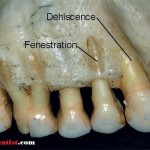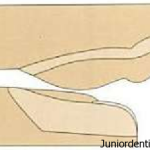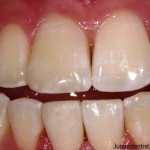Dentin is a Light Yellowish Viscoelastic material made up of Inorganic (Hydroxyapetitie) and Organic (collagenous fibrils and mucopolysaccharides) material which is harder than bone. Dentin thickness is 3-10 mm based on the location. Dentin is made up of dentinal tubules which are S shaped and perpendicular to Dentino enamel junction and Cementoneamel junction. Dentin is […]
Abnormalities in physiologic stages of tooth development
Tooth development is divided into 4 stages based on physiological process of tooth growth: Initiation: It is a part of Bud Stage. For Initiation Epithelial Ectomesenchymal interactions are essential. Initiation is the first step in the development of tooth. Each tooth has its own initiation time and it is not know how this time is […]
Differences between Fenestration and Dehiscence
Fenestration and Dehiscence are two similar conditions of Tooth which are similar due to bone loss around the tooth but are different by the type of bone loss or bone surrounding it. To understand the differences first let us know about What is Fenestration and What Dehiscence: Definition of Tooth Fenestration: Fenestration are Isolated areas […]
Self Correcting Anomalies in Dentistry
Self correcting anomalies are termed as Transient malocclusion, these are not true malocclusion’s but mimic malocclusion during the normal development of dentition and occlusion. they do not need any corrective measures but get corrected themselves as they pass through the developmental stages . Self correcting Anomalies are classified based on the stages of tooth development […]
Differences between Maxillary and Mandibular Incisors – Anatomically
Incisors are the first erupting teeth in both the Deciduous and permanent dentition. There are four Incisors in the Maxillary arch and four Incisors in the Mandibular arch in both deciduous and permanent dentition. The Deciduous Mandibular Central Incisors are the First Teeth to erupt into the oral cavity at an Age of 6 – […]
Embrasures
Embrasures Definition: Two teeth in the same arch are in contact, their curvatures adjacent to the contact areas form Spillway spaces called Embrasures. A Gap between 2 adjacent teeth, as the teeth curve away from the contact area. The Embrassures are usually V-shaped valleys and provide a spill way for food to escape during chewing […]
Masticatory Cycle Phases
The pathway of mandible during chewing is referred to as chewing cycle. Characterized by opening, closing, retrusive, protrusive & lateral jaw movements The chewing cycle can take many forms; classically tear drop shape when viewed in frontal or saggital plane There are about 15 chews in a series from the time of food entry until […]
Minor Salivary Glands Types, Location, and Function
Minor Salivary Glands: There are over 600 minor salivary glands in the Oral Cavity. They are of 2 Types: Mucous Producing Minor Salivary Glands Serous Fluid Producing Minor Salivary Glands Location Of Minor Salivary Glands: Minor salivary glands are found in large numbers on the Cheeks on all side of the Oral cavity which cannot […]
Learn Canine Carving – Video
Here is a video which shows you canine carving in the easiest possible way. Canine Measurements: Length of Tooth: 17mm Length of Crown: 10 mm Mesiodistal diameter of Crown: 7.5mm Mesiodistal diameter of crown at the cervical region: 5.5mm These measurements should be followed and the procedure seen in the video below should be very […]
Gingiva
Gingiva: Gingiva is the soft tissue covering that surrounds the teeth consisting of fibrous tissue which is continuous with the periodontial ligament and the mucosa covering the teeth. Gingiva shows stiplling, which is its typical appearance and is known as stippled gingiva as seen in the above picture. The gingiva is a type of Masticatory […]
Intresting Dental Quotes
1) The best and cheapest dentistry is when the right thing is done extremely well the first time and it lasts for a long time. 2) (good one) Dentist: a prestidigitator who, putting metal into your mouth, pulls coin out of your pocket. 3) Even pearls are dark before the whiteness of his teeth. 4) […]
Muscles of mastication – Origin, Insertion, Function, Nerve and Blood supply
The muscles which are required for mastication or chewing are known as the muscles of mastication. These muscles help mainly in the movement of the mandible and not the maxilla as maxilla is an integral part of the skull and the mandible being the only movable bone in the skull. The muscles help in moving […]
Theories of pain transmission through Dentin
In order to explain the way pain is transmitted to dentin many scientists proposed many theories of pain transmission through dentin to the pulp where the nerves are largely crowded. Pain in general is defined by International Association for the study of Pain (IASP) as – “An unpleasant sensory and emotional experience associated with actual […]
Theories Of Mineralization
Mineralization is a Process taking place in all the calcified structures in the body like the bone & enamel. It is defined as the deposition of the mineral salts in and around the organic matrix to make it a calcified structure. The mineralization process is based on 2 mechanisms: Booster Mechanism Seeding mechanism And it […]









